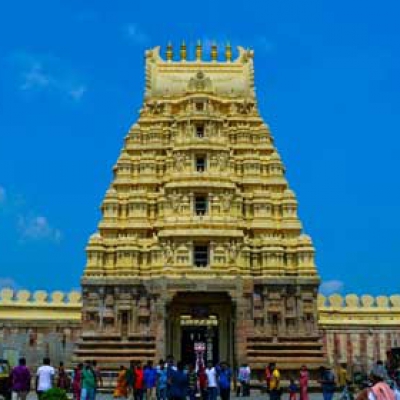
Srirangapatna Temple
The temple is located in the Madya district, a small and important isle in Karnataka. Ranganathar (Lord Vishnu) is the presiding deity in this temple in his reclining posture. The temple is one among the Ranga Kshetrams and every one of them is located in the islands stretching along the Cauvery river.
Srirangapatna Temple- Karnataka
The Adi (first) Rangam is Srirangapatna, the Madhya (middle) Rangam is Shivanasamudra in Karnataka while the Antya (last) or third Rangam is the renowned Srirangam in Tiruchirapalli, Tamilnadu.
Thirumalaiya, an ardent devotee of Lord Vishnu (Ganga Chieftain) had built the Srirangapatna temple. The Hoysala and Vijayanagara Empires had influenced the growth of this temple too. Even Hyder Ali and his warrior son, Tipu Sultan respected this temple for its sanctity, architecture, and artistic charm.
History Of The Temple:
According to the belief of Hindu mythology, River Cauvery is like a mother and she was so pure, she could clear even the sins of the Holy Ganges. There was pollution in River Ganges due to the sins of numerous devotees. River Cauvery imbibed all the impurities and had made the Ganges holy. As she became clogged with endless sins, she prayed Lord Vishnu and underwent a rigorous penance to get his blessings. The benevolence of Lord Vishnu made her happy. Eventually, Lord Vishnu descended down to the River Cauvery to clear off her sins. The Adi Ranga is Srirangapatna which is one of the important residences of Lord Maha Vishnu. This place is also called Gautama Kshetra. Maharishi Gautama had performed penance here to Lord Vishnu in the reclining posture (Sayana Pose).
Specialty
- The temple has massive “Garuda Sthamba” (a typical pillar in Lord Vishnu temples)
- The 24 forms of Lord Vishu carvings are present in the “Chaturvimsati Pillars”.
- Lord Vishnu is in his reclining posture or “Adi Sesha” in this temple.
- There is a separate temple for Goddess Ranganayaki, the life partner of Lord Vishnu
- One idol of Goddess Lakshmi (Goddess of Wealth) is near the feet of Lord Vishnu.
- There is one Lord Krishna Shrine present among the facades of “Acharyas” (instructor) and “Alvars” (Poet-saints of South India) of the Vaishnava tradition (Belonging to Lord Vishnu Worship).
- The famous Srirangapatna battle that killed Tipu Sultan in 1799 happened in this town. There is a memorial too in Srirangapatna marking his demise.
Festivals
Makara Sankranthi Brahmotsava :
In the morning, decoration of Lord Vishnu with butter. In the night, he is adorned with “Vaikuntamudi Crown” (related to Lord Vishnu).
Ratha Sapthami Brahmotsava :
The Big Chariot Festival or Dodda Rathothsava is celebrated.
Magha Shuddha Poornima :
The holy dip (Punya Snana) of thousands of devotees during the full moon day of “Magha Month” (Jan-Feb) of the Hindu Calendar.
Sriranga Jayanthi :
The festival marks the lodging of Sri Ranganatha Swamy in this temple.
Nava Rathri :
Poojas, yaga, homa, sacred offerings, and festivals like Ayudha Pooja and Vijayadasami are important parts of the pompous celebration.
Bangarada Garudotsva :
The festival happens on the full moon day of the “Vaishaka Masa” (April-May) of the Hindu Calendar.
Ashta Theerthotsva :
Thousands of devotees take the holy dip in 8 holy spots where revered sages had once penanced to get the blessings of Lord Vishnu.
Timings
7.30 AM - 1.30 PM and 4.00 PM - 8.OO PM
Dress Code
Traditional attire is recommended for both men and women. However, any decent clothing is fine to enter this temple.
How to reach ?
By Air : The nearest airport is the Mysuru Airport (32 km away from the town). Frequent buses and trains service are available connecting Srirangapatna with Mysore and India. The nearest International Airport is Kempegowda International Airport in Bangalore.
By Train : Srirangapatna Junction has good connectivity with the rest of India.
By Road : On a daily basis, day and night, bus services are available from Bangalore and Mysore. There are also shared taxis and cabs in this region.